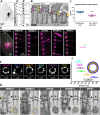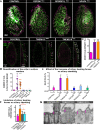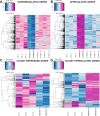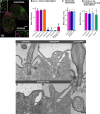MKS-NPHP module proteins control ciliary shedding at the transition zone
- PMID: 32163404
- PMCID: PMC7093003
- DOI: 10.1371/journal.pbio.3000640
MKS-NPHP module proteins control ciliary shedding at the transition zone
Abstract
Ciliary shedding occurs from unicellular organisms to metazoans. Although required during the cell cycle and during neurogenesis, the process remains poorly understood. In all cellular models, this phenomenon occurs distal to the transition zone (TZ), suggesting conserved molecular mechanisms. The TZ module proteins (Meckel Gruber syndrome [MKS]/Nephronophtysis [NPHP]/Centrosomal protein of 290 kDa [CEP290]/Retinitis pigmentosa GTPase regulator-Interacting Protein 1-Like Protein [RPGRIP1L]) are known to cooperate to establish TZ formation and function. To determine whether they control deciliation, we studied the function of 5 of them (Transmembrane protein 107 [TMEM107], Transmembrane protein 216 [TMEM216], CEP290, RPGRIP1L, and NPHP4) in Paramecium. All proteins are recruited to the TZ of growing cilia and localize with 9-fold symmetry at the level of the most distal part of the TZ. We demonstrate that depletion of the MKS2/TMEM216 and TMEM107 proteins induces constant deciliation of some cilia, while depletion of either NPHP4, CEP290, or RPGRIP1L prevents Ca2+/EtOH deciliation. Our results constitute the first evidence for a role of conserved TZ proteins in deciliation and open new directions for understanding motile cilia physiology.
Conflict of interest statement
The authors have declared that no competing interests exist.
Figures




Similar articles
-
MKS5 and CEP290 Dependent Assembly Pathway of the Ciliary Transition Zone.PLoS Biol. 2016 Mar 16;14(3):e1002416. doi: 10.1371/journal.pbio.1002416. eCollection 2016 Mar. PLoS Biol. 2016. PMID: 26982032 Free PMC article.
-
MKS and NPHP modules cooperate to establish basal body/transition zone membrane associations and ciliary gate function during ciliogenesis.J Cell Biol. 2011 Mar 21;192(6):1023-41. doi: 10.1083/jcb.201012116. J Cell Biol. 2011. PMID: 21422230 Free PMC article.
-
Formation of the transition zone by Mks5/Rpgrip1L establishes a ciliary zone of exclusion (CIZE) that compartmentalises ciliary signalling proteins and controls PIP2 ciliary abundance.EMBO J. 2015 Oct 14;34(20):2537-56. doi: 10.15252/embj.201488044. Epub 2015 Sep 21. EMBO J. 2015. PMID: 26392567 Free PMC article.
-
Ciliary transition zone (TZ) proteins RPGR and CEP290: role in photoreceptor cilia and degenerative diseases.Expert Opin Ther Targets. 2012 Jun;16(6):541-51. doi: 10.1517/14728222.2012.680956. Epub 2012 May 7. Expert Opin Ther Targets. 2012. PMID: 22563985 Free PMC article. Review.
-
Molecular genetics and pathogenic mechanisms for the severe ciliopathies: insights into neurodevelopment and pathogenesis of neural tube defects.Mol Neurobiol. 2011 Feb;43(1):12-26. doi: 10.1007/s12035-010-8154-0. Epub 2010 Nov 27. Mol Neurobiol. 2011. PMID: 21110233 Review.
Cited by
-
Basal bodies bend in response to ciliary forces.Mol Biol Cell. 2022 Dec 1;33(14):ar146. doi: 10.1091/mbc.E22-10-0468-T. Epub 2022 Oct 26. Mol Biol Cell. 2022. PMID: 36287828 Free PMC article.
-
Renal insufficiency caused by TMEM216 gene mutation: Case Report.Front Med (Lausanne). 2025 Apr 29;12:1579732. doi: 10.3389/fmed.2025.1579732. eCollection 2025. Front Med (Lausanne). 2025. PMID: 40365501 Free PMC article.
-
Composition, organization and mechanisms of the transition zone, a gate for the cilium.EMBO Rep. 2022 Dec 6;23(12):e55420. doi: 10.15252/embr.202255420. Epub 2022 Nov 21. EMBO Rep. 2022. PMID: 36408840 Free PMC article. Review.
-
Cilia and Extracellular Vesicles in Brain Development and Disease.Biol Psychiatry. 2024 Jun 1;95(11):1020-1029. doi: 10.1016/j.biopsych.2023.11.004. Epub 2023 Nov 11. Biol Psychiatry. 2024. PMID: 37956781 Free PMC article. Review.
-
STORM imaging reveals the spatial arrangement of transition zone components and IFT particles at the ciliary base in Tetrahymena.Sci Rep. 2021 Apr 12;11(1):7899. doi: 10.1038/s41598-021-86909-5. Sci Rep. 2021. PMID: 33846423 Free PMC article.
References
-
- Huang L, Szymanska K, Jensen VL, Janecke AR, Innes AM, Davis EE, et al. TMEM237 is mutated in individuals with a Joubert syndrome related disorder and expands the role of the TMEM family at the ciliary transition zone. Am J Hum Genet. 2011. December 9;89(6):713–30. 10.1016/j.ajhg.2011.11.005 - DOI - PMC - PubMed
Publication types
MeSH terms
Substances
LinkOut - more resources
Full Text Sources
Other Literature Sources
Research Materials
Miscellaneous

